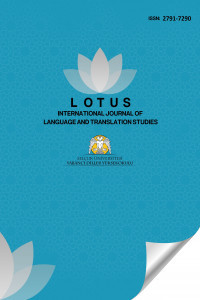SHAKESPEARE’İN MACBETH ESERİNİN TÜRKÇE ÇEVİRİSİNDE KÜLTÜRE ÖZGÜ KİNAYELERİN ÇEVİRİSİ
Drama, insana ve topluma ayna tutan, insan doğasını ve yaşamını kendi sosyal-kültürel yapısı içinde okuyucuya veya izleyiciye aktaran bir edebi türdür. Her oyun, sahnelendiği zaman ve kültür içinde yeni bir gerçeklik kazanır ve her performans aslında oyuna yeni bir yorum getirir. Benzer şekilde her çeviri kaynak metne yeni bir anlam katar. Başka bir deyişle, tercüme edilen tiyatro metni, dilinin ve kültürünün sınırlarını aşarak yeni bir yorum bulur. Böylece drama çevirisi kültürler arası bir iletişim olarak bir kültürden diğerine aktarım olarak gerçekleşir. Bu bağlamda, kültüre özgü referansların tercüme edilmesi, hedef toplumun kültürel yönlerini yansıtması açısından kilit bir rol oynamaktadır. Bu çalışma, Venuti'nin çeviri ilkeleri olan yerlileştirme ve yabancılaştırmayı Shakespeare'in Macbeth'inin Türkçe çevirisinde kültüre özgü kinayelerin aktarımında kullanımını araştırmayı amaçlamaktadır. Macbeth, hedef dilde ve kültürde karşılığı olmayan dini, kültürel, mitolojik gibi kültüre özgü kinayelerin aktarımı açısından Türkçe versiyonuyla karşılaştırılmıştır. Venuti'nin bu ilkelerini değerlendirmek için Davies'in çeviri stratejileri de uygulanmaktadır.
Anahtar Kelimeler:
Drama çevirisi, kültüre özel kinayeler, Macbeth
TRANSLATION OF CULTURE-SPECIFIC REFERENCES IN THE TURKISH TRANSLATION OF SHAKESPEARE’S MACBETH
Drama is a literary genre that mirrors the people and society and transfers the human nature and life to the reader or the audience within its own social-cultural structure. Each play takes on a new reality in the time and culture of the staging, and each performance actually brings a new interpretation to the play. Similarly, each translation adds a new meaning to the source text. In other words, the translated theatrical text transcends the boundaries of its language and culture and finds a new interpretation. Thus, the translation of drama takes place as a transfer from one culture to another as a cross cultural communication. In this context, translating culture specific references play a key role in terms of reflecting cultural aspects of a target society. This study aims to explore the use of Venuti's translation principles of domestication and foreignization in the transfer of culture specific references in the Turkish translation of Shakespeare's Macbeth. Macbeth is compared with its Turkish version in terms of the transference of culture specific references such as religious, cultural, and mythological, which have no equivalent in the target language and culture. To evaluate these principles of Venuti, Davies’s translation strategies are also conducted.
Keywords:
Drama translation, Culture specific references, Macbet.,
___
- Aixelà, J.F. (1996). Culture-specific Items in Translation. In R. Álvarez & M. Carmen Africa Vidal (Eds.), Translation, Power, Subversion. Clevedon: Multilinugal Matters Ltd.
- Apaydın, A. (2016). Translation of Shakespeare’s legacy “Macbeth” on the 400th anniversary of his death. CBÜ Sosyal Bilimler Dergisi, 14(1), 65-78.
- Baker, M. (1992). In other words: A coursebook on translation. London: Routledge.
- Bassnett, Susan. (1985). Ways through the labyrinth. In Theo Hermans (ed.). Worcester: Billing & Sons Limited.
- Bassnett, S., & Lefevere, A. (1990). Translation, history and culture. London: Printer Publishers.
- Bassnett, S. (2002). Translation studies. London and New York: Routledge
- Bassnett, Susan. (n.d.) Culture and Translation. Retrieved December 4, 2019 from https://www.academia.edu/37858519/Culture_and_Translation_Why_did_Translation_Studies_take_a_Cultural_Turn
- Davies, E. (2003). A Goblin or a Dirty Nose?. The Translator, 9(1), 65-100. Retrieved 25 November 2019, from https://scinapse.io/papers/1539344507
- Gentzler, E. (2001). Contemporary translation theories. Clevedon: Multilingual Matters.
- Gökçeoğlu, E. (2019). A comparative analysis of culture-specific items in English translations of Ahmet Hamdi Tanpinar's saatleri ayarlama enstitüsü (Master’s Thesis, Hacettepe Universtiy, Ankara, Turkey). Retrieved from https://tez.yok.gov.tr/UlusalTezMerkezi/tezSorguSonucYeni.jsp İşi, N. (2017) Analysis of culture-specific items in the English translation of Nazım Hikmet's Memleketimden İnsan Manzaraları. (Master’s Thesis, Hacettepe Universtiy, Ankara, Turkey). Retrieved from https://tez.yok.gov.tr/UlusalTezMerkezi/tezSorguSonucYeni.jsp
- Lefevere, A. (2016). Translation, rewriting, and the manipulation of literary fame. London: Routledge.
- Newmark, P. (1987). A textbook of translation. (p. 95-103). Hemel Hempstead: Prentice-Hall International.
- Pedersen, J. (2005). How is culture rendered in subtitles? In MuTra Conference Proceedings. Retrieved December 4, 2019, from http://www.euroconferences.info/proceedings/2005_Proceedings/2005_Pedersen_Jan.pdf
- Shakespeare, W. (1968). Macbeth. London: Longmans.
- Shakespeare, W. (2015). Macbeth, (Özdemir Nutku, Trans.) İstanbul: Mitos Boyut Yayınları.
- Snell-Hornby, M. (1990). Linguistic transcoding or cultural transfer? A critique of translation theory in Germany. In S. Bassnett & A. Lefevere (Eds.). Translation, history and culture. London and New York: Pinter Publishers.
- Simon, S. (2005). Gender in Translation Studies. New York: the Taylor & Francis e-Library.
- Venuti, L. (2018). The translator's invisibility. London: Routledge.
- Başlangıç: 2021
- Yayıncı: Selçuk Üniversitesi
Sayıdaki Diğer Makaleler
BÜYÜK BİLGİ - MÜZİK HAKKINDA NOTLAR
YENİ SANSÜR MODELİ KAPSAMINDA GREY WOLF’UN ÖN KAPAKLARININ DÖNÜŞÜMÜ
RADİKAN KAVRAMINA ÇEVİRİBİLİM AÇISINDAN BİR YAKLAŞIM: RADİKAN ÇEVİRİ
SHAKESPEARE’İN MACBETH ESERİNİN TÜRKÇE ÇEVİRİSİNDE KÜLTÜRE ÖZGÜ KİNAYELERİN ÇEVİRİSİ
LINGUISTIC STUDY OF SELECT TURKISH PLACE NAMES THROUGH THE KALEIDOSCOPE OF GREEK VOCABULARY
